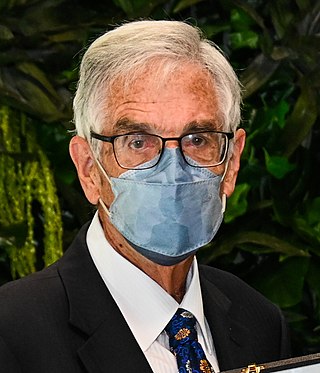
Gopalasamudram Narayanan Ramachandran, or G.N. Ramachandran, FRS was an Indian physicist who was known for his work that led to his creation of the Ramachandran plot for understanding peptide structure. He was the first to propose a triple-helical model for the structure of collagen. He subsequently went on to make other major contributions in biology and physics.

Sir Ernest Marsden was an English-New Zealand physicist. He is recognised internationally for his contributions to science while working under Ernest Rutherford, which led to the discovery of new theories on the structure of the atom. In Marsden's later work in New Zealand, he became a significant member of the scientific community, while maintaining close links to the United Kingdom.

Bruce Michael Alberts is an American biochemist and the Chancellor’s Leadership Chair in Biochemistry and Biophysics for Science and Education, Emeritus at the University of California, San Francisco. He has done important work studying the protein complexes which enable chromosome replication when living cells divide. He is known as an original author of the "canonical, influential, and best-selling scientific textbook" Molecular Biology of the Cell, and as Editor-in-Chief of Science magazine.
Keith Edward Bullen FAA FRS was a New Zealand-born mathematician and geophysicist. He is noted for his seismological interpretation of the deep structure of the Earth's mantle and core. He was Professor of Applied Mathematics at the University of Sydney in Australia from 1945 until 1971.

Britton "Brit" Chance was an American biochemist, biophysicist, scholar, and inventor whose work helped develop spectroscopy as a way to diagnose medical problems. He was "a world leader in transforming theoretical science into useful biomedical and clinical applications" and is considered "the founder of the biomedical photonics." He received the National Medal of Science in 1974.
Dame Carole Jordan, is a British physicist, astrophysicist, astronomer and academic. Currently, she is Professor Emeritus of Astrophysics at the University of Oxford and Emeritus Fellow at Somerville College, Oxford. From 1994 to 1996, she was President of the Royal Astronomical Society; she was the first woman to hold this appointment. She won the Gold Medal of the Royal Astronomical Society in 2005; she was only the third female recipient following Caroline Herschel in 1828 and Vera Rubin in 1996. She was head of the Rudolf Peierls Centre for Theoretical Physics at the University of Oxford from 2003 to 2004 and 2005 to 2008, and was one of the first female professors in Astronomy in Britain. She was made a Dame Commander of the Order of the British Empire in 2006 for services to physics and astronomy.

Alan Henry Kirton was a New Zealand agricultural scientist.

Richard Henderson is a British molecular biologist and biophysicist and pioneer in the field of electron microscopy of biological molecules. Henderson shared the Nobel Prize in Chemistry in 2017 with Jacques Dubochet and Joachim Frank.
Sir Philip Cohen is a British researcher, academic and Royal Medal winner based at the Medical Research Council Protein Phosphorylation and Ubiquitylation Unit, School of Life Sciences at the University of Dundee.
Harden M. McConnell was an American physical chemist. His many awards included the National Medal of Science and the Wolf Prize, and he was elected to the National Academy of Science."

Sir Christopher Martin Dobson was a British chemist, who was the John Humphrey Plummer Professor of Chemical and Structural Biology in the Department of Chemistry at the University of Cambridge, and Master of St John's College, Cambridge.

Sir Peter David Gluckman is a New Zealand scientist. Originally trained as a paediatrician, he served as the inaugural Chief Science Advisor to the New Zealand Prime Minister from 2009 to 2018. He is a founding member and was inaugural chair of the International Network for Government Science Advice, and is president of the International Science Council.
Michael Charles Corballis was a New Zealand and Canadian psychologist and author. He was Emeritus Professor at the Department of Psychology at the University of Auckland. His fields of research were cognitive psychology and cognitive neuroscience, encompassing visual perception, visual imagery, attention, memory, and the evolution of language.
Francis Brian Shorland was a New Zealand organic chemist.
The Shorland Medal is awarded annually by the New Zealand Association of Scientists in recognition of a "major and continued contribution to basic or applied research that has added significantly to scientific understanding or resulted in significant benefits to society." The medal was established in 1999 and named after Brian Shorland, a New Zealand organic chemist.
Bishnupada Mukerjee or Bishnupada Mukhopadhyaya was an Indian pharmacologist and orthopedic surgeon, known for his contributions in the fields of pharmacological research and standardization of drugs in India. The Government of India honoured him in 1962, with the award of Padma Shri, the fourth highest Indian civilian award for his services to the nation.
Robert Paul Kibblewhite was a New Zealand scientist noted for his research into the properties of wood fibre, particularly in relation to the pulp and paper industry.
Brian Halton was a New Zealand organic chemist. He is noted for his investigation of highly strained and fused aromatic compounds, and was also active as an historian of chemistry.

Sir William Alexander Denny is a New Zealand medicinal chemist, noted for his work investigating drugs for the treatment of cancer.
Ronald Bruce Miller was a New Zealand soil chemist and scientific administrator. He rose to become director of the Soil Bureau in 1973, and later served as chief director of the Department of Scientific and Industrial Research.









